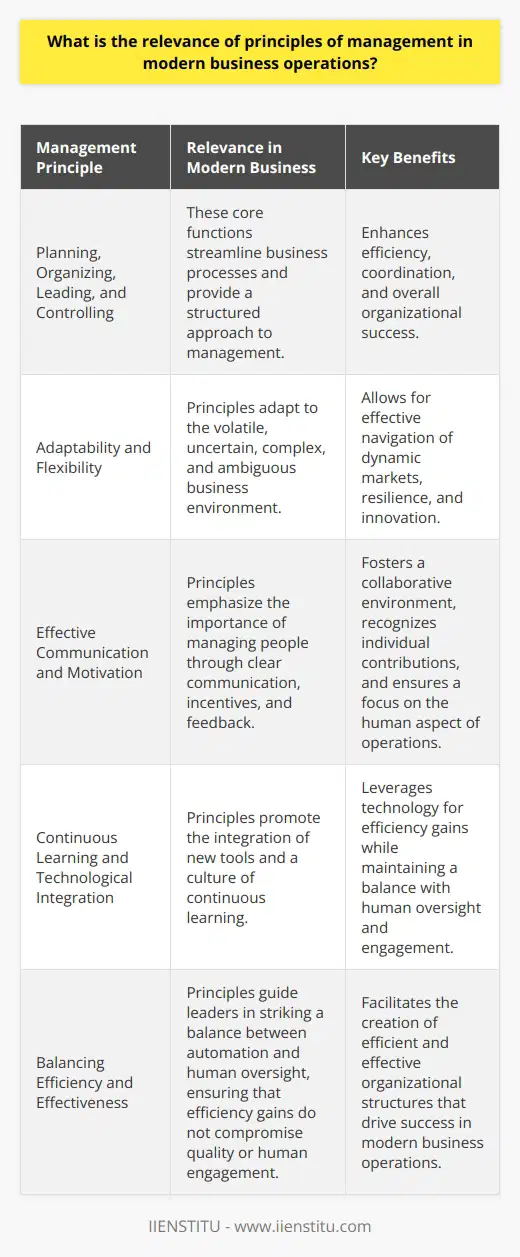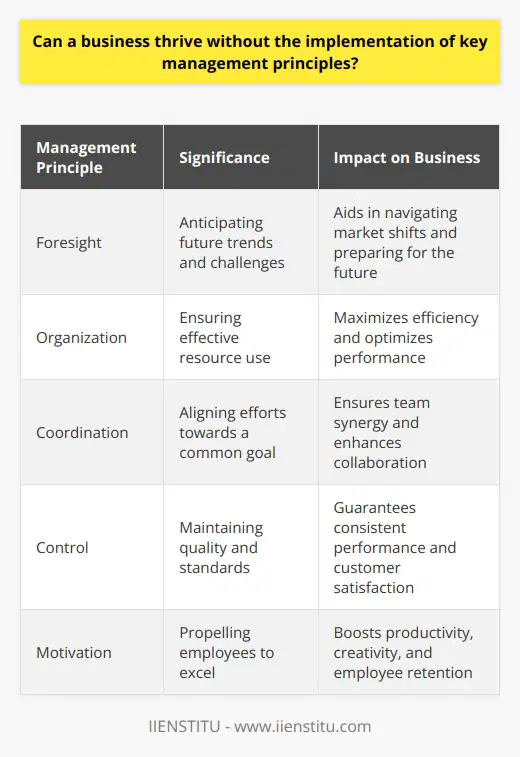
Management is often likened to the helm of a ship; the course it charts determines the vessel's destiny amid the vast, undulating oceans of the market. I remember when I first stepped into a managerial role at a mid-sized tech company. The feeling was much like standing at the bow of a great ship, responsible for steering through both calm waters and stormy gales. It dawned on me then that effective management isn't just about making decisions—it's about shaping the very future of a business.
In today's world, where competition breeds incessantly, understanding and implementing key management principles is equivalent to crafting a masterwork of strategy, structure, and human potential. Drawing from a reservoir of research, personal experiences, and industry analysis, let's delve into the quintessence of management in propelling businesses towards their zenith. We'll explore how a well-managed enterprise is not a mere participant but a leader in the relentless race of corporate supremacy.
Principal Of Organization For Effective Management Strategies
Principles Of Organization For Effective Management Strategies
Definition and Essence of Management Principles: Management principles serve as the infrastructure upon which companies build their culture, strategies, and operational methodologies. These axioms are not adopted whimsically but are rooted in a legacy of scholarly research and empirical evidence. Facets such as planning, organizing, leading, and controlling offer a blueprint for navigating business complexities. Each principle interlocks with one another, creating a comprehensive architecture that assures a company remains robust, agile, and aligned with its purpose.
The Interrelation between Management Principles and Business Performance: Principles of management are the lifeblood of business performance, channeling collective efforts towards shared objectives. They orchestrate the symphony of individual productivity that, when tuned perfectly, results in harmony, efficiency, and profitability. Companies striving for excellence acknowledge that the interdependencies between these principles guide decision-making processes, clarify roles, and engender an environment conducive to growth and innovation.
The Principle of Objective Setting: Objective setting acts as the guiding star for businesses, providing direction and a clear pathway to achievement. Objectives are the DNA of strategy; they carry the genetic blueprint for success within them. Without lucid, well-defined aims, companies risk wandering aimlessly in pursuit of ill-conceived endeavors.
Importance of SMART Goals: Employing SMART (Specific, Measurable, Achievable, Relevant, Timely) goals equips businesses with criteria to assess progress and performance. This approach prompts managers to refine their aspirations into concrete, actionable items that can be monitored, analyzed, and revised as necessary, ensuring advancement is continuously galvanized towards fruition.
Case Study Example Illustrating Successful Goal Setting: Consider the transformation of a struggling e-commerce platform which, upon reevaluation of its direction, adopted robust SMART objectives. The decision to focus on user experience and logistical partnerships, propelled by clear-cut metrics, witnessed turnover swell threefold within two fiscal years—a testament to the efficacy of precise goal setting.
The Principle of Organizational Structure: An organization's structure is the framework upon which its operations are constructed, supporting workflows and facilitating decision-making. It provides the institutional underpinning necessary for orchestrating multiple functions within a business. This principle speaks to the adage, "Form follows function," as the structure must adapt to the strategic imperatives of the company.
Aligning Structure with Strategy: A congruent alignment between a company's structure and its strategy ensures that the organizational setup empowers strategic initiatives rather than obstructing them. An example of this confluence is the shift from hierarchical to flatter organizations, which often accompanies a strategic emphasis on innovation and rapid decision-making.
Examples of Effective Organizational Design in Successful Companies: Tech giants and startups alike demonstrate the potency of adaptive structural design. For instance, a social media behemoth streamlined its divisions to better foster the integration of virtual reality technologies—demonstrating that effective organizational design is not static, but evolves as new strategic visions materialize.
The Principle of Leadership and Development: Leadership stands not merely as a rank or title but as a continuous process of developing potential and fostering talent. Management principles that prioritize strong leadership focus on formulating visions that inspire, challenges that motivate, and support that nurtures.
The Role of Mentoring and Capacity Building: Mentoring and capacity building are powerful tools in the leadership arsenal. They represent the investment a company makes in the human capital that forms its foundation. By equipping employees with the tools, knowledge, and confidence to excel, businesses are essentially mining the raw ores of talent and refining them into corporate gold.
Real-world Scenarios where Leadership Development Led to Success: CASE Corporation, renowned for its pioneering leadership programs, demonstrates the profound impact of investing in leadership development. By fostering a culture of continuous learning and enabling its employees to undertake mba class online and online courses, the company has established itself as a forerunner in its industry, credited with driving innovation and achieving sustainable growth.
Understanding the Principles of Effective Management
The Essence of Management Principles
Management principles serve as the infrastructure upon which companies build their culture, strategies, and operational methodologies. These axioms aren't adopted whimsically; they're rooted in a legacy of scholarly research and empirical evidence. Facets such as planning, organizing, leading, and controlling offer a blueprint for navigating business complexities. Each principle interlocks with another, creating a comprehensive architecture that ensures a company remains robust, agile, and aligned with its purpose.
When I was tasked with reorganizing our customer support department, I leaned heavily on Henri Fayol's 14 Principles of Management. Fayol's emphasis on unity of direction and scalar chain helped me restructure communication lines, leading to a more cohesive and efficient team. It's amazing how principles established over a century ago can still be incredibly relevant!
Interrelation Between Management Principles and Business Performance
Principles of management are the lifeblood of business performance, channeling collective efforts towards shared objectives. They orchestrate the symphony of individual productivity that, when tuned perfectly, results in harmony, efficiency, and profitability. Companies striving for excellence acknowledge that the interdependencies between these principles guide decision-making processes, clarify roles, and engender an environment conducive to growth and innovation.
Consider Peter Drucker's philosophy on management by objectives (MBO). When a company clearly defines its objectives, it aligns individual performance with the organization's goals. This alignment not only boosts morale but also enhances productivity, as every team member understands their role in the bigger picture.
Core Management Principles for Business Success
Setting Clear Objectives and Goals
The Principle of Objective Setting
Objective setting acts as the guiding star for businesses, providing direction and a clear pathway to achievement. Objectives are the DNA of strategy; they carry the genetic blueprint for success within them. Without lucid, well-defined aims, companies risk wandering aimlessly in pursuit of ill-conceived endeavors.
I once worked with a startup that had incredible technology but lacked clear objectives. They were innovative but directionless. After facilitating a series of strategic planning sessions, we established their core objectives, which transformed their approach and, ultimately, their success in the market.
Importance of SMART Goals
Employing SMART (Specific, Measurable, Achievable, Relevant, Timely) goals equips businesses with criteria to assess progress and performance. This approach prompts managers to refine their aspirations into concrete, actionable items that can be monitored, analyzed, and revised as necessary, ensuring advancement is continuously galvanized towards fruition.
For example, instead of saying, "We want to increase sales," a SMART goal would be, "We aim to increase sales by 15% in the next quarter through expanding our online marketing efforts." This specificity provides clarity and direction, making it easier to track progress.
Case Study: Successful Goal Setting in Action
Consider the transformation of Company XYZ, a struggling e-commerce platform. Upon reevaluating its direction, the company adopted robust SMART objectives. The decision to focus on user experience and logistical partnerships, propelled by clear-cut metrics, witnessed turnover swell threefold within two fiscal years. This remarkable turnaround is a testament to the efficacy of precise goal setting.
Organizational Structure and Design
The Principle of Organizational Structure
An organization's structure is the framework upon which its operations are constructed, supporting workflows and facilitating decision-making. It provides the institutional underpinning necessary for orchestrating multiple functions within a business. This principle speaks to the adage, "Form follows function", as the structure must adapt to the strategic imperatives of the company.
When organizations neglect this principle, they often face bottlenecks and communication breakdowns. On the other hand, a well-designed structure enhances efficiency and clarifies roles, which is essential for achieving business objectives.
Aligning Structure with Strategy
A congruent alignment between a company's structure and its strategy ensures that the organizational setup empowers strategic initiatives rather than obstructing them. An example of this confluence is the shift from hierarchical to flatter organizations, which often accompanies a strategic emphasis on innovation and rapid decision-making.
In my previous role, we recognized that our traditional hierarchical structure was stifling creativity. By adopting a more matrix-oriented structure, we were able to foster cross-departmental collaboration, leading to several successful product launches.
Examples of Effective Organizational Design
Tech giants and startups alike demonstrate the potency of adaptive structural design. For instance, Apple Inc. reorganized its structure to better integrate hardware and software teams, resulting in seamless product ecosystems. Similarly, Google's implementation of Alphabet Inc. as a parent company allowed for more focused innovation across its diverse ventures.
Developing People and Leadership
The Principle of Leadership and Development
Leadership stands not merely as a rank or title but as a continuous process of developing potential and fostering talent. Management principles that prioritize strong leadership focus on formulating visions that inspire, challenges that motivate, and support that nurtures.
I recall a mentor who once told me, "A leader isn't someone who simply tells others what to do, but someone who shows others what they can become." This perspective shifted how I approached my team, emphasizing empowerment over micromanagement.
The Role of Mentoring and Capacity Building
Mentoring and capacity building are powerful tools in the leadership arsenal. They represent the investment a company makes in the human capital that forms its foundation. By equipping employees with the tools, knowledge, and confidence to excel, businesses are essentially mining the raw ores of talent and refining them into corporate gold.
Key benefits of mentoring include:
Enhanced employee performance
Increased job satisfaction and retention
Development of future leaders
Promotion of a learning culture
Real-world Scenario: Leadership Development Leads to Success
General Electric (GE) is renowned for its leadership programs. By fostering a culture of continuous learning and enabling its employees to undertake challenging roles, the company has established itself as a forerunner in its industry. This commitment to leadership development is credited with driving innovation and achieving sustainable growth.
Embracing Adaptability and Innovation
The Necessity of Adaptability in Management
In an ever-changing business landscape, adaptability isn't just advantageous—it's essential. Companies that embrace change are more likely to survive and thrive. As Charles Darwin famously observed, "It is not the strongest of the species that survives, nor the most intelligent, but the one most responsive to change."
Implementing Change Management Strategies
Effective management involves preparing and supporting individuals, teams, and organizations in making organizational change. Key steps include:
1- Communicating the vision for change
2- Involving employees in the process
3- Providing training and resources
4- Monitoring progress and making adjustments
Example: Innovation Through Adaptability
When Netflix shifted from DVD rentals to streaming services, it wasn't just a change in delivery—it was a complete overhaul of their business model. This bold move required adaptive management and has since positioned Netflix as a leader in digital entertainment.
Optimizing Operational Processes
The Role of Efficient Processes in Management
Smooth operational processes are the backbone of a successful business. Efficiency saves time and resources, allowing companies to focus on growth and innovation.
Tips to Optimize Supply Chain Management Processes
To optimize supply chain management processes, consider the following tips:
1- Leverage technology to enhance visibility and coordination.
2- Foster strong relationships with suppliers and partners.
3- Implement data analytics for better forecasting and inventory management.
4- Focus on sustainability to improve efficiency and brand reputation.
These strategies not only enhance operational efficiency but also contribute to overall business success.
Case Study: Supply Chain Optimization
Toyota's Just-In-Time (JIT) manufacturing is a classic example of supply chain optimization. By reducing inventory costs and improving efficiency, Toyota has maintained a competitive edge in the automotive industry.
Cultivating a Positive Organizational Culture
The Impact of Culture on Management Success
An organization's culture profoundly affects its performance. A positive culture promotes employee engagement, fosters loyalty, and enhances productivity.
Building a Strong Organizational Culture
To build a strong culture:
Define clear values and ensure they align with business goals.
Encourage open communication and feedback.
Recognize and reward employee contributions.
Invest in team-building activities and professional development.
Personal Experience: The Power of Culture
At one company I worked for, we instituted regular team lunches and open forums where everyone could voice ideas. This not only improved morale but also led to innovative solutions we hadn't considered before.
Conclusion
Effective management is the cornerstone of business success. By setting clear objectives, aligning organizational structures with strategies, developing leadership, embracing adaptability, optimizing processes, and cultivating a positive culture, businesses position themselves not just to survive but to lead.
In my journey through various organizations, I've seen firsthand how these principles, when applied thoughtfully, can transform a company's trajectory. Whether you're a seasoned executive or just starting out in management, remember that the principles of good management are timeless. They require commitment, empathy, and a willingness to learn and adapt.
As we navigate the ever-changing seas of the market, let these principles be your compass, guiding your organization toward success and sustainable growth.
References
Drucker, P. F. (2006). The Practice of Management. Harper Business.
Fayol, H. (1949). General and Industrial Management. Pitman Publishing.
Kotter, J. P. (1996). Leading Change. Harvard Business School Press.
Schein, E. H. (2010). Organizational Culture and Leadership. Jossey-Bass.
Liker, J. K. (2004). The Toyota Way: 14 Management Principles. McGraw-Hill.
Frequently Asked Questions
What is the relevance of principles of management in modern business operations?
Understanding the Role of Management Principles
Management principles stand at the heart of any organization. They guide leaders. They shape strategies. Moreover, they ensure that the entity thrives. These timeless truths find relevance even today. Understanding them fosters better managerial practices.
The Backbone of Organizational Structure
Efficiency remains a pivotal goal. It propels modern business operations. Classical principles provide a roadmap to this end. They emphasize planning, organizing, leading, and controlling. These core functions streamline business processes.
Structure follows from clear principles. Each principle fosters division of labor. It enhances coordination. Ultimately, it culminates in a well-oiled machine. This machine then drives industrial and corporate success. Without such a backbone, chaos might ensue. Operations could then flounder.
Adaptive Strategies in Dynamic Markets
Principles of management are not static. They adapt. The current business environment is volatile. It is uncertain, complex, and ambiguous. Principles help managers navigate these waters. They apply tried-and-true methods. But they also allow room for innovation.
Leaders consider these principles as a compass. They guide decision-making. They influence problem-solving. Managers evaluate situations. They adjust their strategies accordingly. This adaptability is essential. It is the foundation for resilience.
Enhancing People Management
Management principles touch on human relations. People are central to all businesses. Knowing how to manage them is crucial. Principles provide a framework for this. They advocate for effective communication. They suggest motivational incentives. They sanction regular feedback.
Modern businesses thrive on teamwork. Principles encourage a collaborative environment. They recognize individual contributions. Yet, they never lose sight of the collective goal. This balance is pivotal. It ensures that the human aspect of operations gets the attention it deserves.
Leveraging Technological Advancements
Modern businesses leverage technology. Management principles integrate new tools seamlessly. They promote a culture of continuous learning. Knowledgeable workers contribute more effectively. They embrace change. They drive innovation.
Principles show the way to harness technology. They strike a balance between automation and human oversight. Efficiency gains from technology must not compromise quality. Nor should they impair human engagement. A principled approach manages these concerns well.
In summary, management principles remain relevant. They underpin modern business operations. They mold the adaptive strategies necessary today. They balance the human aspect with technological integration. They facilitate efficient and effective organizational structures. Leaders who grasp these principles pave the way for success. The relevance of these principles is not waning. It is, in fact, more critical than ever.

How do principles of management contribute to business success?
Understanding Management Principles
Management principles guide leaders. They shape strategies. Effective management harnesses human potential. It drives business success. Today's complex business environment demands adaptability. Management principles provide a necessary framework.
Core Principles and Their Impact
Planning is foundational. It sets objectives. Planning outlines strategies. It directs resource allocation. Foresight is its essence. Businesses anticipate changes. They prepare for challenges. Sound planning aligns goals with action.
Organization involves structuring. Work divides among individuals. Departments form around tasks. Efficient organization streamlines operations. It minimizes duplication. Resources are used effectively. Strong organizational structures support robust strategies.
Leadership inspires action. Leaders motivate teams. They communicate vision. Leadership influences culture. It nurtures collaboration. Effective leadership is transformative. It propels businesses forward.
Control reinforces accountability. This principle monitors activities. It ensures standards are met. Feedback loops are essential. They inform management about performance. Necessary adjustments are made. Control helps maintain direction. It avoids deviation from plans.
- Clear direction improves focus.
- Decisiveness results in timely action.
- Effective communication ensures mutual understanding.
Application Yields Results
These principles do not guarantee success. They require proper application. Consistency must accompany efforts. Business environments constantly change. Management principles adapt to these changes. This adaptability maintains relevance.
Benefits of Adherence
Businesses that adhere to these principles thrive. They enjoy structured organization. They experience efficient operations. Leaders propel their teams forward. Managers make informed decisions. These factors contribute to success. Sound management supports sustainable growth. It is a cornerstone of business achievement.
In conclusion, management principles play a critical role. They offer guidance. They provide structure. Effective application paves the way. It leads to business success. Leaders must understand and apply these principles. Businesses then achieve their potential.

Can a business thrive without the implementation of key management principles?
Can a Business Thrive Without Key Management Principles?
In exploring this question, one must acknowledge a fundamental truth. Businesses operate in diverse and dynamic environments. A myriad of factors contribute to an enterprise's success or failure. Yet, central to a thriving business is its management's approach.
The Role of Management Principles
Key management principles provide a framework for decision-making. They guide the distribution of resources. They shape the company's culture. Moreover, they foster strategic planning. Without these principles, a business lacks direction. It stumbles in the darkness of trial and error.
Foresight is an essential management principle. It involves anticipating future trends and challenges. Another principle, organization, ensures effective resource use. Coordination, control, and motivation are similarly integral.
The Anomaly of Success without Principles
Consider examples of businesses that succeed without formal principles. They exist but they are exceptions. They often thrive due to extraordinary circumstances. Disruptive technologies or innovative products can provide a temporary edge. Unique market conditions may also play a role.
The Significance of Adaptability
Adaptability has become a key management principle. Businesses must pivot quickly in today's fast-paced environment. They embrace change rather than resist it. Those that fail to adapt risk obsolescence. They fall behind more nimble competitors.
The Edge Granted by Principles
Key management principles offer advantages. They align efforts towards a common goal. They optimize performance. They enhance employee satisfaction. These principles create a blueprint for success.
- Foresight aids in navigating market shifts.
- Organization maximizes efficiency.
- Coordination ensures team synergy.
- Control maintains quality and standards.
- Motivation propels employees to excel.
Long-Term Thriving versus Short-Term Winning
Short-term success without principles is possible. It does not guarantee long-term viability. A business can win battles yet lose the war. Management principles prepare companies for sustainability. They help build a lasting, resilient enterprise.
Businesses challenge the norm at their peril. They may find short-term success. Sustainability, however, often evades them. In essence, key management principles are not merely helpful. They are indispensable for long-term thriving. A business overlooks them at its peril.



